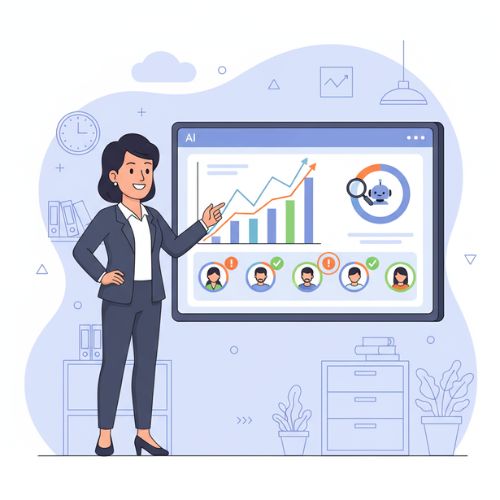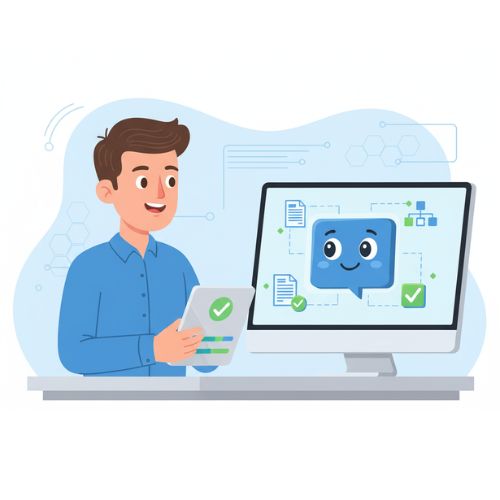Improving SharePoint Policy Management with AI Chatbots
Effective policy management is essential for maintaining compliance, ensuring employee adherence, and just making life easier on employees. SharePoint, a staple in many organizations for document storage and collaboration, excels at housing policies but often falls short in accessibility and real-time interaction. Enter AI chatbots that can improve how teams interact with policies stored in SharePoint. This guide explores how integrating AI chatbots can elevate your policy management, making it more efficient, user-friendly, and compliant.
Understanding SharePoint's Role in Policy Management
SharePoint serves as a robust platform for storing and organizing policies, SOPs (Standard Operating Procedures), and compliance documents. It allows for version control, permissions-based access, and integration within the Microsoft ecosystem, including Microsoft Teams. However, traditional SharePoint setups can lead to challenges, including cumbersome searches, outdated document retrieval, and limited employee engagement. Employees might spend valuable time navigating folders or contacting HR or compliance teams for clarifications, which can hinder productivity and increase non-compliance risks.
For departments such as human resources and compliance, where policies are frequently referenced, these limitations underscore the need for improvement. AI chatbots bridge this gap by providing instant, conversational access to SharePoint-hosted content.
The Power of AI Chatbots in Enhancing Policy Access
AI chatbots change how organizations interact with policies stored in systems like SharePoint, transforming static document repositories into dynamic, user-friendly knowledge hubs. By leveraging natural language processing (NLP) and machine learning, these chatbots deliver instant, accurate responses to policy queries, streamline workflows, and ensure compliance across various departments, including human resources, quality assurance, compliance, and information technology. This section explores how AI chatbots enhance policy access, detailing their capabilities, benefits, and real-world applications, with a focus on improving efficiency, accessibility, and employee engagement. With custom chatbots, organizations can address common challenges—such as cumbersome searches and outdated documents—while fostering a culture of compliance and productivity.
Instant, Conversational Access to Policies
Understanding User Queries: AI chatbots excel at interpreting natural language, allowing employees to ask questions in everyday language, such as “What’s our policy on remote work?” or “How do I handle a CAPA deviation?” Unlike SharePoint’s traditional keyword searches, which often return irrelevant results, Botable’s AI uses NLP to grasp context and intent, pulling precise answers from the latest SharePoint documents. For example, a quality assurance team member can instantly access standard operating procedures without navigating complex folder structures, saving time and reducing errors.
Real-Time Document Retrieval: Botable’s chatbots integrate seamlessly with SharePoint, retrieving policies in real time. This ensures that employees always access the most current versions, which is critical for regulated industries adhering to standards like ISO 13485. For instance, when a compliance officer asks about audit requirements, the chatbot delivers the exact document section, complete with hyperlinks for deeper exploration, as noted in Botable’s using AI for compliance guide. This immediacy eliminates delays caused by manual searches or outdated intranet links.
Personalized Responses: The AI tailors answers to user roles or departments. An HR employee might receive a simplified explanation of benefits policies, while an IT administrator gets detailed privacy guidelines. Botable’s chatbot personalization capabilities enhance user experience, making policies feel accessible and relevant, which boosts employee engagement.
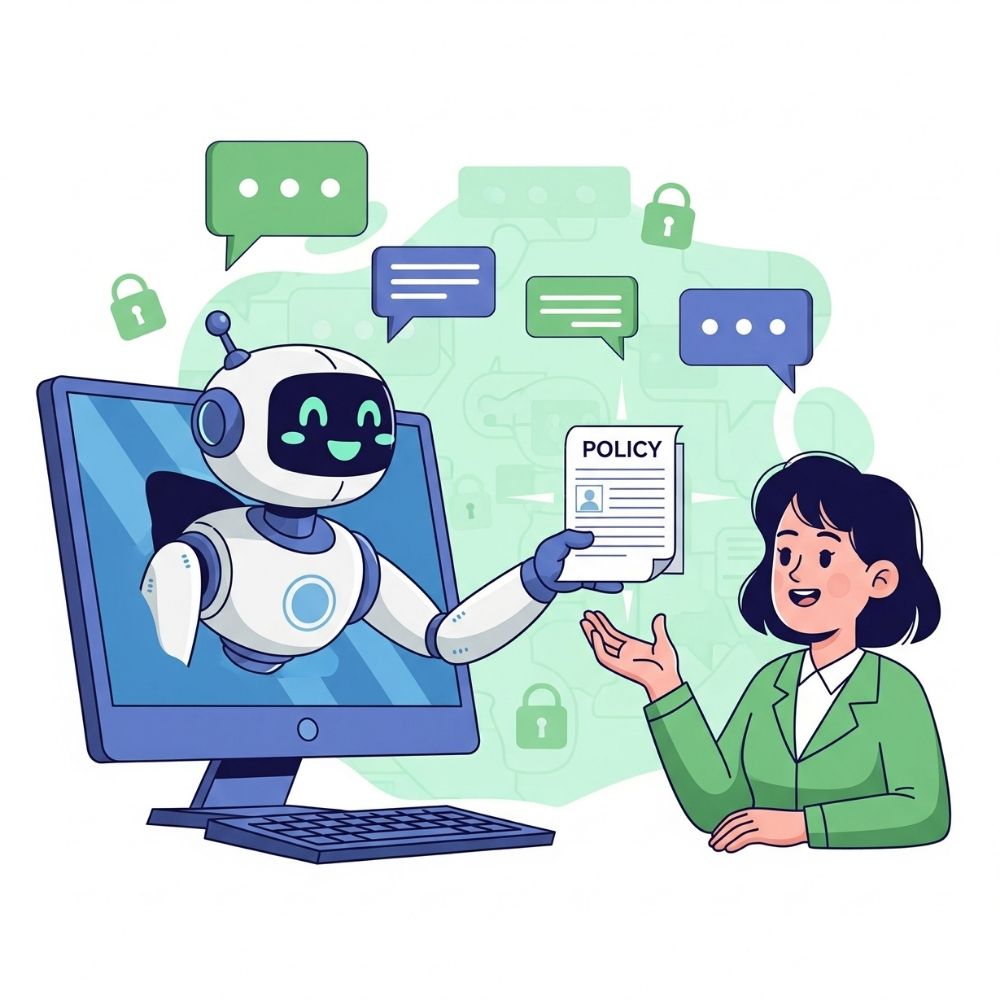
Enhanced Accessibility for Diverse Teams
Dynamic Language Translation: For global organizations, language barriers can hinder policy adoption. Botable’s AI chatbots offer real-time translation, allowing employees to access policies in their native languages. This is particularly valuable for multi-language onboarding, ensuring that a Spanish-speaking HR team member or a Mandarin-speaking QA engineer can understand complex SOPs. By indexing SharePoint documents with dynamic language document search, the chatbot delivers translated responses instantly, fostering inclusivity.
24/7 Availability: Unlike human helpdesks, AI chatbots are available round-the-clock, supporting employees across time zones. This is a game-changer for information technology teams handling urgent security policy queries or human resources staff assisting with employee self-service outside of regular business hours. This constant access reduces downtime and empowers employees to resolve issues independently.
Integration with Collaboration Tools: Botable’s chatbots integrate with platforms like Microsoft Teams, allowing employees to query policies directly within their workflow. For example, a sales and marketing team member can ask about branding guidelines during a Teams meeting and receive an immediate response without leaving the app.
{{cta}}
Compliance and Audit Readiness
Automated Policy Updates: AI chatbots monitor SharePoint for policy changes, ensuring employees receive the latest versions. This is crucial for compliance teams managing regulatory standards such as ISO 9001 or ISO 13485. For instance, when a policy is revised, Botable’s AI proactively notifies relevant users, thereby reducing non-compliance risks, as discussed in the context of how AI chatbots transform ISO 9001 compliance.
Audit Trails for Accountability: Every chatbot interaction is logged, creating a traceable record of who accessed what policy and when. This is invaluable during audits, as it provides compliance teams with clear documentation. These logs also help identify frequently asked questions, informing policy updates or training needs.
Proactive Guidance: Beyond answering queries, chatbots guide employees through complex processes. For example, in quality assurance, the AI can guide a user through a CAPA process, referencing insights from the CAPA system. This ensures adherence to protocols and minimizes errors, enhancing audit readiness.
Boosting Productivity and Employee Experience
Reducing Administrative Burden: By handling repetitive policy queries, chatbots free up HR, IT, and compliance teams to focus on strategic tasks. For example, instead of fielding questions about employee handbooks, HR can focus on employee engagement initiatives. Botable’s HR chatbot FAQ highlights how automation can cut query resolution times by up to 70%.
Empowering Self-Service: AI chatbots enable employees to find answers independently, reducing reliance on helpdesks. This aligns with employee self-service technology, empowering users to resolve issues like benefits enrollment or IT policy questions quickly. The result is a more confident, productive workforce.
Driving Continuous Improvement: Chatbots provide analytics on query patterns, helping organizations refine policies. For instance, frequent questions about a specific SOP might indicate a need for clearer documentation.
{{cta}}
Key Benefits of Integration
Integrating AI chatbots with SharePoint offers multifaceted advantages:
Improved Accessibility and Search Efficiency: Traditional keyword searches in SharePoint can be limiting. AI chatbots enable semantic searches, understanding context and intent to deliver precise results from vast document libraries. This is especially useful for information technology teams managing IT policies.
Enhanced Compliance and Risk Reduction: Chatbots monitor policy updates in real-time, notifying users of changes and ensuring adherence to standards like ISO 13485. By logging interactions, they provide audit trails that support compliance audits, as discussed in our guide on using AI for compliance.
Boosted Employee Engagement and Productivity: With 24/7 availability, chatbots handle repetitive queries, freeing up HR and compliance staff for strategic tasks. They also personalize responses, improving the employee experience and encouraging self-service.
Seamless Collaboration Across Departments: Integration fosters better communication, preventing data silos. For example, sales and marketing teams can quickly access branding policies without disrupting workflows.
These benefits not only streamline operations but also contribute to a culture of continuous improvement, as seen in Quality 4.0 initiatives.
Step-by-Step Guide to Implementing AI Chatbots in SharePoint
Implementing AI chatbots to enhance policy management in SharePoint transforms static document repositories into dynamic, user-friendly systems. This integration streamlines access to critical policies, boosts compliance, and enhances efficiency for departments like human resources, quality assurance, compliance, and information technology. Using tools like Botable's AI solutions, organizations can improve employee experience and reduce administrative burdens. Below is a detailed, 1000-word guide outlining each step, with practical tips, potential challenges, and best practices to ensure a seamless rollout, drawing on Botable's expertise in policy management and integrations.
1. Assess Your Current Setup
A thorough assessment of your SharePoint environment lays the groundwork for a successful integration of chatbots. This step identifies pain points and tailors the solution to your organization's specific needs, ensuring alignment with key goals such as compliance and efficiency.
Map Your SharePoint Structure: Begin by reviewing how policies are organized. Are employee handbooks in HR libraries, SOPs in QA folders, or compliance documents scattered across sites? Utilize SharePoint's analytics to track document usage and identify frequently accessed policies, such as remote work guidelines or ISO 13485 standards. This helps pinpoint high-priority areas for chatbot integration.
Gather Stakeholder Input: Engage departments like human resources and compliance. Ask about challenges, such as time spent on policy queries or audit preparation. For global teams, note language barriers, as discussed in Botable’s overcoming language barriers in SOPs. Surveys or interviews can reveal specific needs, like faster access for information technology teams managing security policies.
Quantify Pain Points: Measure metrics like search times (often 20-30% of knowledge workers’ day) or helpdesk ticket volumes for policy clarifications. SharePoint’s audit logs can highlight trends, such as frequent searches for employee self-service policies.
Prioritize Features: Based on findings, list must-have chatbot capabilities, such as real-time updates, multi-language support, or integration with Microsoft Teams. This step, typically 1-2 weeks, ensures the chatbot addresses real needs, enhancing quality management systems.
2. Choose the Right AI Chatbot Solution
Selecting a chatbot that aligns with SharePoint’s architecture and your organization’s goals is critical for long-term success. The right tool ensures seamless integration and scalability.
Research Enterprise-Grade Options: Look for chatbots with proven SharePoint compatibility. Botable excels here, offering API-driven connections to retrieve policies securely, as detailed in our integrations resources. Its platform supports complex queries and compliance needs, like those in using AI for compliance.
Evaluate Key Features: Prioritize natural language processing (NLP) for contextual queries, such as “What’s our CAPA process?”—Botable’s AI handles this well, per our CAPA system AI guide. Ensure compliance features like audit trails and encryption, vital for ISO 13485 audits.
Consider Scalability and Customization: Select a solution that accommodates a wide range of use cases, from HR to sales and marketing. Botable scales easily, offering features like multi-language onboarding.
Assess ROI and Support: Review case studies, such as Galvanize Therapeutics, where query times decreased by 70%. This evaluation, spanning 2-4 weeks, ensures a robust solution that enhances policy management software.
{{cta}}
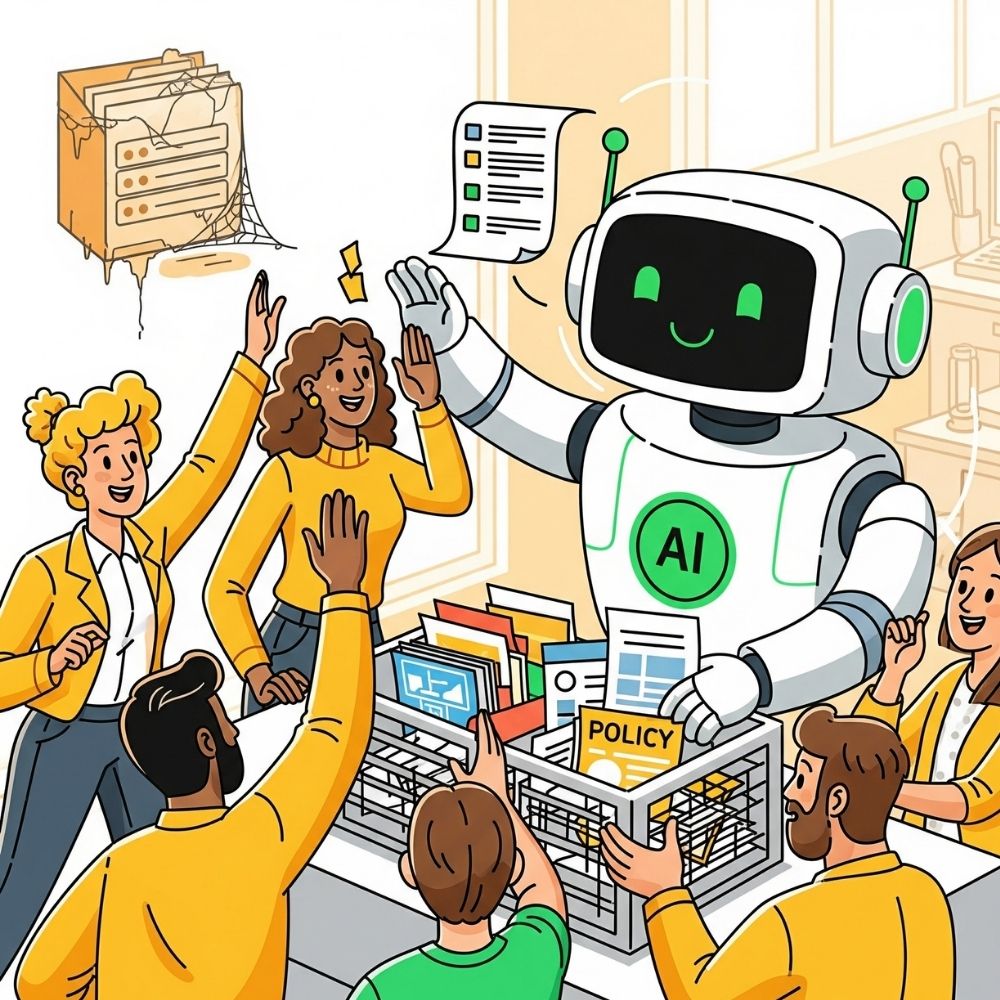
3. Set Up Integration
Establishing a secure, efficient connection between the chatbot and SharePoint is the technical core of the project. This step ensures policies are accessible via conversational interfaces.
Configure Authentication: Use Azure Active Directory for single sign-on, respecting SharePoint’s permission models.
Enable Data Syncing: Import policies into the chatbot’s knowledge base. Use APIs to map metadata, linking HR policies to relevant queries.
Test Connectivity: Run sample queries to verify accuracy, addressing issues such as API limits or firewall blocks. Our integrations blog offers troubleshooting tips.
Add Advanced Features: Enable full-text search for nuanced queries, as in Botable’s full-text search in quality management. Include dynamic translation for global teams to enhance accessibility.
This phase, lasting 1-3 weeks, creates a secure bridge that transforms SharePoint into a proactive hub for compliance and quality assurance.
4. Train and Customize the Chatbot
Training ensures the chatbot delivers accurate, context-aware responses tailored to your organization’s needs.
Upload and Index Documents: Feed SharePoint policies into the chatbot using Botable’s dashboard to categorize them, such as grouping SOPs under 'standard operating procedures'.
Fine-Tune Terminology: Train on industry-specific terms, such as “root cause analysis” for quality teams, referencing Botable’s AI root cause analysis guide. Use sample queries to handle ambiguities, ensuring the bot distinguishes between HR and IT policies.
Customize User Experience: Personalize interactions, such as greeting users by role or suggesting relevant resources like onboarding chatbots. Enable multi-language support for diverse teams, as outlined in Botable’s dynamic language document search.
Incorporate Feedback Loops: Conduct initial training with mock interactions, refining based on accuracy metrics. Botable’s analytics track performance, enhancing employee self-service.
This step, spanning 2-4 weeks, creates a chatbot that feels like a natural extension of your team, boosting employee engagement.
5. Test and Launch
Rigorous testing and a strategic launch ensure the chatbot is reliable and widely adopted.
Pilot with a Small Group: Test with representatives from human resources and information technology. Simulate real scenarios, like querying policies or testing updates.
Gather Feedback: Use surveys to assess intuitiveness and time savings. Refine features, such as adding chatbot personalization, based on input.
Launch Company-Wide: Announce via internal channels, highlighting benefits like 24/7 access. Train users with brief sessions, and monitor adoption with Botable’s analytics to measure ROI, such as reduced helpdesk tickets.
This phase, taking 1-2 weeks for testing and one for launch, drives efficiency in policy management software.
6. Maintain and Optimize
Ongoing maintenance ensures the chatbot remains effective, adapting to new policies and user needs.
Schedule Regular Updates: Sync new policies weekly and retrain the AI on changes. Use Botable’s AI insights for optimizations, like identifying query trends.
Monitor Performance: Review interaction logs for compliance, addressing issues promptly. Botable’s analytics help track metrics like query resolution times, ensuring alignment with compliance standards.
Foster Continuous Improvement: Incorporate user feedback through quality improvement feedback loops. Regularly assess performance to identify areas for enhancement, such as adding features for AI for event deviation recording.
Scale as Needed: Expand the chatbot’s scope to additional departments or features, like supporting Quality 4.0 initiatives. This ensures long-term value and adaptability.
This ongoing step, guided by Botable’s beginner’s guide to policy manual software, keeps your integration robust and future-proof.
{{cta}}
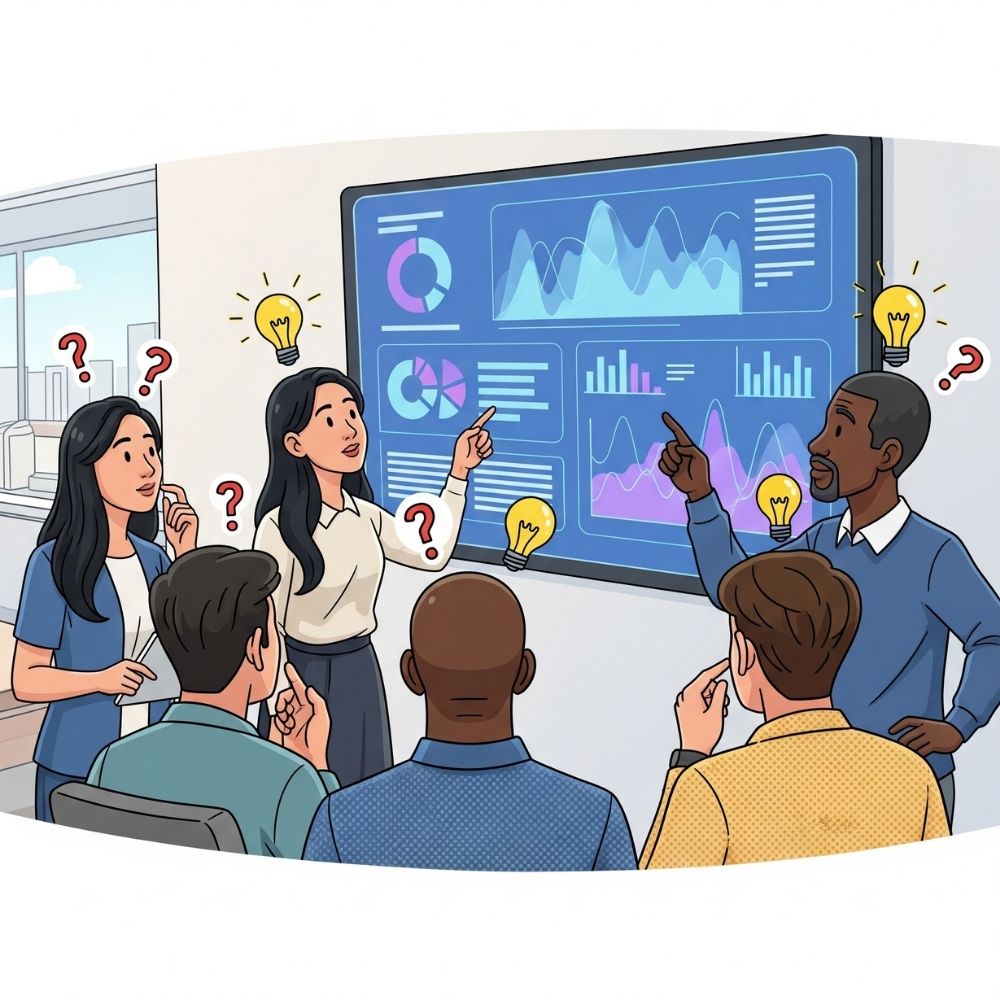
Future-Proof Your Policy Management
Enhancing SharePoint policy management with AI chatbots isn't just an upgrade—it's a strategic move toward agile, compliant operations. Tools like Botable empower your team to focus on innovation rather than searching for information. Whether you work in human resources, compliance, or another area, this integration can enhance your workflow.
Ready to get started? Contact our sales team for a demo tailored to your needs.
Answers your employees need, right when they need them
Meet Botable — the AI chatbot that handles everything from simple FAQs to complex, multi-step questions, so your team can focus on what matters. Built for HR, QA, and beyond.
Continue reading
Ready to see what Botable can do for you?
Book your demo now to see how Botable can transform your workplace.
Identify your unique challenges
Flexible pricing options
Easy integrations
Step-by-step implementation plan
Customize Botable for your workflow
Book a demo
.webp)


